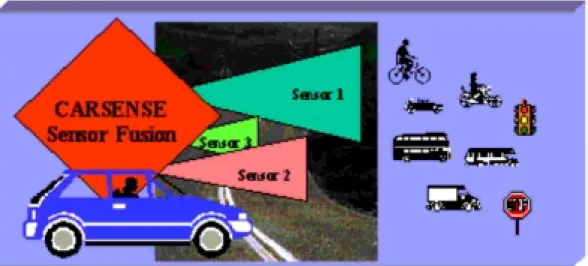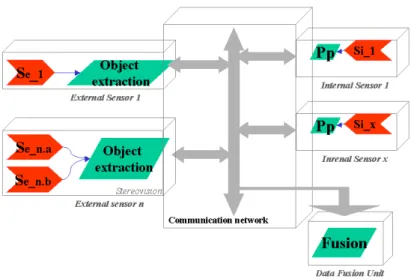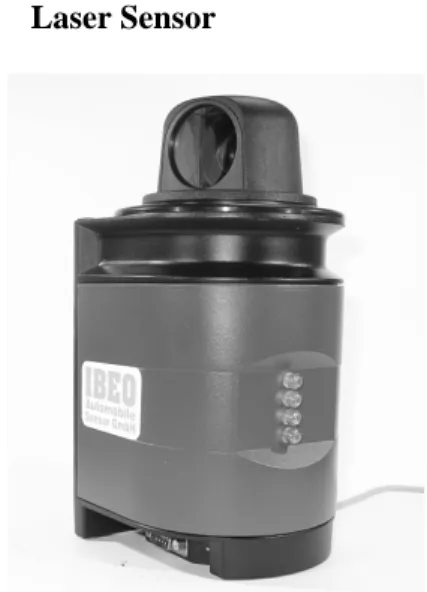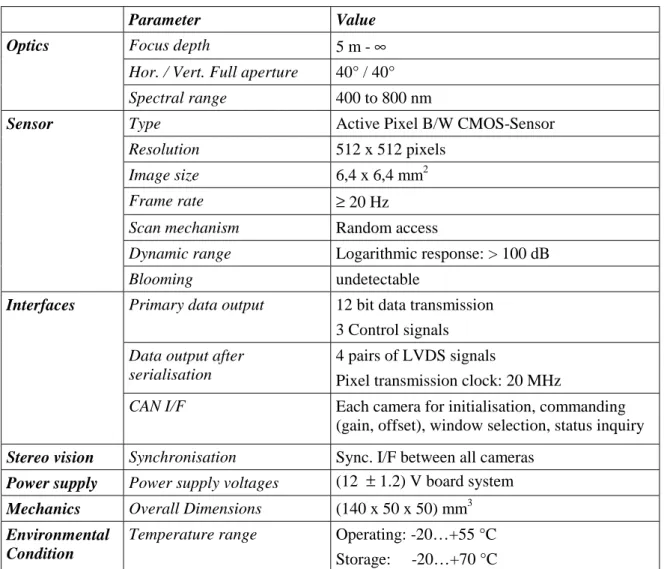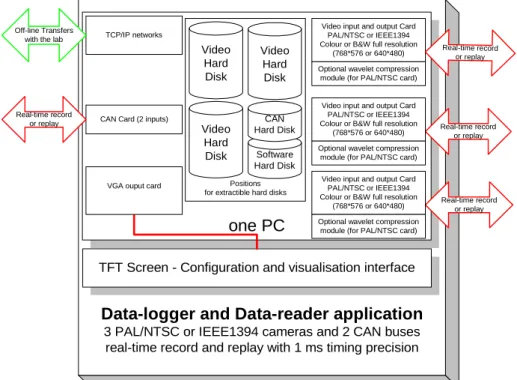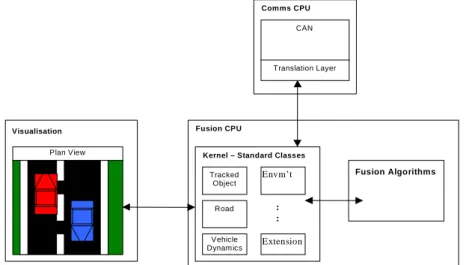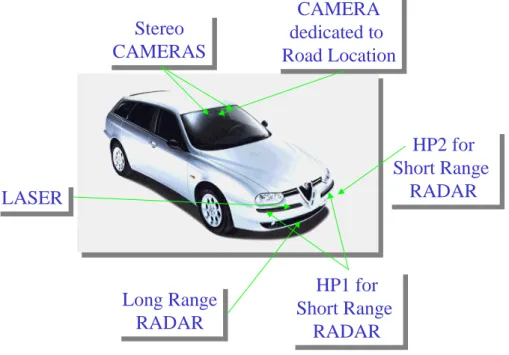SENSING OF CAR ENVIRONMENT AT LOW SPEED DRIVING
Dr. J. Langheim AUTOCRUISE Dr. R. Divko BMW AG F. Tango CRF JP Artis Thomson-CSF Detexis Dr. M. Wahl Dr. S. Ambellouis INRETS-LEOST Ch. Lavergne M. Spigai RENAULT U. Lages, M. Dittmer IBEO S. Ludwig Dr. W. Reiland JENA-OPTRONIK Dr. M. Parent, Dr. Th. Fraichard, Dr. E. Marchand INRIA Dr. J.-Ph. Tarel Dr. D. Aubert Dr. M. Mangeas Dr. J.M. Blosseville LIVIC Dr. A.Buchanan M.Thompson A.Trace C.Shooter TRW Automotive B. Steux, P. Coulombeau, Pr. C. Laurgeau ENSMP 1. AbstractA consortium of 12 European car manufacturers, suppliers and research institutes have grouped together to form the CARSENSE programme. The programme, sponsored by the EC, is to develop a sensor system, the purpose of which is to provide sufficient information on the car environment at low speeds to assist in low speed driving in complex (urban) environments. This article describes the main objectives of the programme, these being the improvement of the individual sensors and the merger of the information from these sensors in a fusion unit.
2. Introduction
The concept of Adaptive Cruise Control (ACC), developed through previous research activities, was introduced to the market in 1999. This was the first Advanced Driver Assistance System (ADAS) on the market. All surveys and experimental assessments have proved that users have shown a high interest and product acceptance for such systems.
ACC is only the beginning, with current developments focusing on more advanced functions. Future ADAS will help the driver in significantly more complex driving tasks than those available today. The driver can choose to hand over part-control to the ADAS in a wider variety of traffic situations than has previously been possible.
The first step ACC systems commercially available today are based on single sensor approaches, using either Radar or Laser sensors. These ADAS are very much limited to use on motorways or urban expressways without crossings. The traffic situations evaluated by these systems consist only of other vehicles, such as cars and trucks moving in simple patterns. This means that processing is restricted and can be focussed on few, well defined detected objects. Nevertheless, even for these relatively simple situations, these first systems cannot cope reliably with fixed obstacles. They also occasionally behave in an unexpected manner, causing surprise to the driver in 'cut-in' situations. The term 'cut-in' refers to other vehicles pulling in closely in front of the vehicle. Here, the width of the sensor beam may not fully cover the area in front of the vehicle, resulting in a late response from the ADAS.
3. CARSENSE Objectives
When such ADAS are in wider use, it will be necessary to extend the operation envelope to cover more complex situations, such as dense traffic environments in in sub-urban or urban areas. There, traffic is characterised by lower speeds, traffic jams, tight curves, traffic signs, crossings and “weak”
currently available for monitoring the driving environment provide only a very small amount of the information which is necessary to manage these higher level driving tasks. It has been identified
within the ADASE joint research project, in the 4th Framework Programme, that one of the crucial
requirements for achieving significant progress in ADAS technology is a considerable increase in the performance of the driving environment monitoring systems. This includes larger range, greater precision and higher reliability of the sensor information, as well as additional attributes. The way to reach this goal is to improve existing sensors, such as radar, laser and video, as well as to fuse the information/output of these different sensor systems with appropriate scene models to achieve better accuracy, redundancy, robustness, and an increase of the information content.
The presented project will develop a sensing system and an appropriate flexible architecture for driver assistance systems, with the aim being to advance the development of ADAS for complex traffic and driving situations, initially at low speeds. The ADASE project identified that driver assistance at low speed is the next most feasible function after the introduction of ACC. However, this functionality requires two of the fundamental steps towards future ADAS: reliable information about stationary objects and a wider field of view, albeit only in the near range. While the development of this application is outside the scope of the present project, low speed driving applications will serve to define the requirements for the sensor system and the development of it's architecture.
Experience from previous research and development programmes shows that individual sensorial components are not sufficiently reliable in complex traffic scenarios. Improved perception systems and methods are needed to detect fixed targets, and to handle complex traffic configurations in urban areas. Innovative features of the CARSENSE programme include:
- Introduction of a complex scenario for driver assistance systems opening the way towards assisted/autonomous driving in dense urban traffic
- Innovative sensor system architecture, which meets future requirements for an easy exchange and
upgrade of improved hardware and software modules (Radar, Laser, Video)
- Data fusion of individual sensors to produce a system with improved performance
- Improvement of individual sensors towards higher performance ADAS using novel detection principles and processing methods
- Combination of complementary European companies, creating a team that utilises the synergy between the partners to create a new sensing system
• Requirements and Scenarios
The first priority of CARSENSE is the improvement of existing ACC systems to cope with low speed scenarios. During the requirements capture phase, the partners defined the needs of a future sensing system for application in ADAS.
A typical application field / environment for use of a CARSENSE ADAS is on urban expressways such as the Paris "Periphérique", or the large roads parallel to the "Periphérique". Traffic on such roads is characterised by :
• Traffic jams with stopped or slow driving vehicles
• Many motorcycles
• Crossings
• Mixture of motorised traffic with bicycles and pedestrians
• Complicated road configurations with curves, bridges, mini-tunnels and road-works
Based on the definition of the "typical" traffic situation for which the CARSENSE system was conceived, a set of scenarios was precisely defined in order to fulfil the following develoment requirements :
• Representative for slow speed traffic
• Replay of scenarios
• Easy realisation
Today's ADAS cannot reliably cope with the difficulties posed by high traffic complexity and the large number of objects involved. Consequently, the basic setting for the definition of CARSENSE scenarios is concentrated on realistic scenarios with, in general, more than just a few vehicles (or other objects) involved. The scenarios defined can be classified into the following categories:
• Evaluation of false alarms
• Following in dense traffic
• Cut in, cut out
• Lane change maneuvers with 2 or more objects involved
• Unique stationary obstacle, moving ADAS equipped vehicle
• Several stationary obstacle, moving ADAS equipped vehicle
• Other obstacles (size, shape, color of different objects vary)
• Fixed->moving obstacle, stationary ADAS equipped vehicle
• Other scenarios (Crossing, oncoming traffic)
Figure 2 shows typical cut-in and cut-out scenarios in urban situations.
Based on these agreed scenarios, chosen to cover a large spectrum of low speed real-life situations, data from various sensors will be acquired simultaneously and recorded along with additional driving sequence description scripts. The scripts provide the partners with the means for calibrating their sensors and for testing their algorithms. LCPC (LIVIC department) will use it's own test tracks to achieve this task. The multi-sensor acquisition stage compares the information produced by the sensors. Some basic diagnostics will be made on the sensors ability to cope with the requirements. These tests will assist in the determination of further developments necessary for each single sensor, as well as providing cues for the fusion of the data from the various sensors.
At the end of the project, a second set of tests will permit a study of the performance of each newly designed sensor. These will also help assess the benefits of sensor fusion and allow an evaluation of the detection performance of the entire system, and its capacity for coping with low speed driving situations.
Fig. 2: Cut-in / -out situations
• Architecture
The CARSENSE system is a multi-sensor data fusion system designed to detect objects in front of the host car. This multi-sensor data fusion system consists of a set of internal and external sensors from where information is fused within a single data fusion unit. Internal sensors give information about the host vehicle state, such as its velocity and steering angle information. External sensors (Laser, Radar, and image sensors) sense information external to the vehicle, such as the detection of obstacles. All the sensors and the data fusion unit are connected via CAN busses.
Fig. 3: CARSENSE obstacle detection architecture
The system architecture (Figure 3) shows how the external sensors, performing object detection, provide the data fusion unit with this information. Consequently the data fusion unit will be able to improve object detection accuracy by using multiple sources of information.
The INRETS-LEOST laboratory, which has already an experience in obstacle detection architecture [1,2], is currently working in collaboration with all the partners, to achieve a modular and flexible software-hardware architecture. This architecture must meet both the individual sensor partners requirements, as well as the data fusion application ones. Some of these requirements are:
- testing of the object detection from both the data fusion unit and individual sensors, based on the
- testing of 'degraded mode' performance of the data fusion unit (i.e. lost of one sensor)
- flexibility to allow the addition of new sensors.
Meanwhile an initial architecture will be implemented for the first vehicle testing phase, to allow the collection of sensor information (know as the CARSENSE datalogger architecture). This will allow both sensor improvement and design, as well as the development of data fusion algorithms by TRW, INRIA, LCPC-LIVIC and INRETS-LEOST. For this initial phase, more CAN busses will be embedded in the vehicle than is actually necessary, to facilitate scenario datalogging. Upon completion of this stage the vehicle will be modified to allow the implementation of the new architecture, producing an obstacle data fusion system.
Further revisions may occur at later stages of the project, prior to the final vehicle test. The introduction of a bus with higher performance may be also envisaged [3].
• Radar Sensor
Radar sensors are currently at the heart of many ACC systems, which have been on the market since 1999.
One very important step in the development of such radar systems was the introduction of the Gallium Arsenid (GaAs) technology. The Autocruise radar uses GaAs based Monolithic Microwave Integrated Circuits (MMIC). In comparison to conventional technologies this offers several advantages. Some of these advantages are increased manufacturability, due to the simple structure of the radar, increased reliability and lifetime, and compact packaging. Calibration of the radar and the time required to install it in vehicle are minimised. MMIC based radars have the potential to be produced at a low cost level that is acceptable to automotive customers [4].
The main technical characteristics of the radar (Fig. 4) are:
• Frequency: 76-77 GHz
• Range: <1 - > 150 m
• Search Area: 12°
• Speed measurement precision: < 0.2 km/h
• Angular Precision: < 0.3°
The main feature of the radar is that it is realised with minimum hardware and an emphasis on software for achieving a high performance level.
The radar uses the Doppler signal for direct speed measurement. Its measurement of relative speed is extremely precise (< 0.2 km/h). This is an extremely important feature, which allows the development comfortable longitudinal control algorithms that handle dynamic traffic situations.
At the core of the radar is the transmitter / receiver module (T/R – Module). It contains all the microwave circuits necessary for the radar function. These use MMIC technology.
Within the CARSENSE project, this radar sensor will be improved by Thomson-CSF Detexis on two fronts:
• Widened field of view in the short range area (+/- 35 ° up to about 40 m)
• Improved detection of fixed targets
• Laser Sensor
The IBEO laser scanner LD Automotive (Fig. 5) is a high-resolution scanner with an integrated DSP for sensor-internal signal processing [5,6].
The laserscanner emits pulses of near infrared light and measures the incoming reflections of those pulses. The distance to the target is directly proportional to the time between transmission and reception of the pulse. The scanning of the measurement beam is archived via a rotating prism. The measurements of one scan form a 2-D profile of the environment. The single measurements are overlapping, in order to avoid gaps. This is necessary for the detection of slim objects.
The main characteristics (of the current laser sensor) are:
• Viewing angle: up to 270°
• Angular beam separation: 0,25°
• Beam divergence: 5 mrad (beam diameter: 50 cm in 100 m)
• Scan frequency: 10 Hz
• Distance range:
• reflecting targets: up to 250 m
• dark targets (reflectivity 5 %): up to approx. 40 m
• Standard deviation of a single shot measured distance: +/- 5 cm (1 sigma)
• Eye-safe laser (laser class 1)
The measurement control is done by a micro-controller. The distances and corresponding angles result in 2D range raw data profiles, which are transmitted to the DSP where application-specific calculations are performed in real-time. The raw data are divided into segments, which are assigned to objects. These objects are tracked using Kalman-filters. Object parameters like position, size and velocity are calculated through this process. They are transmitted to the host computer via a CAN bus.
• High Dynamic Stereo Video Camera
For stationary and mobile object detection (and additional functions, such as lane detection, traffic sign recognition, rear- and side-view sensing) Jena-Optronik GmbH is developing a digital video (stereo) camera system with high dynamic range and high geometrical resolution.
In contrast to Charged Coupled Devices (CCDs) and most Active Pixel (CMOS) Sensors, which cover a dynamic range of up to 70 dB, a high performance CMOS-Sensor is used which exhibits a logarithmic signal response. This has a dynamic range of more than 100 dB and prevents blooming effects caused by overexposure. This feature allows the detection of large intensity variations, typical for all-day traffic scenes (e.g. driving out of tunnels, driving against sunrise and sunset or driving at night with oncoming headlights).
The first camera generation uses a black and white sensor with 512 x 512 pixels and provides a frame
rate of ≥ 20 Hz. Products with even higher geometrical resolution (1024 x 1024 pixels) and enhanced
infrared sensitivity (up to 950 nm) are in preparation.
CMOS-cameras are also very attractive from an operational point of view. CMOS technologies are inherently less sophisticated than CCD technologies and are therefore better suited for operation in the severe automotive environment.
Due to less expensive production and further integration and miniaturisation potential (on-chip ADC and image pre-processing) CMOS-cameras are also very attractive from a commercial point of view, especially for high-volume manufacture.
Parameter Value
Focus depth 5 m - ∞
Hor. / Vert. Full aperture 40° / 40°
Optics
Spectral range 400 to 800 nm
Type Active Pixel B/W CMOS-Sensor
Resolution 512 x 512 pixels
Image size 6,4 x 6,4 mm2
Frame rate ≥ 20 Hz
Scan mechanism Random access
Dynamic range Logarithmic response: > 100 dB
Sensor
Blooming undetectable
Primary data output 12 bit data transmission 3 Control signals
Data output after serialisation
4 pairs of LVDS signals
Pixel transmission clock: 20 MHz
Interfaces
CAN I/F Each camera for initialisation, commanding (gain, offset), window selection, status inquiry
Stereo vision Synchronisation Sync. I/F between all cameras
Power supply Power supply voltages (12 ± 1.2) V board system
Mechanics Overall Dimensions (140 x 50 x 50) mm3
Environmental Condition
Temperature range Operating: -20…+55 °C Storage: -20…+70 °C
Table 1 : Specification of the First Generation Video Camera
• Image Processing Hardware
It is important that the image processing algorithms developed in the CARSENSE programme are capable of running in 'real-time', considered in this case to be equivalent to the frame rate of the Video Sensor (20Hz). Consequently, TRW is developing a high performance hardware platform, incorporating both field programmable gate array (FPGA) and digital signal processor (DSP) technologies, capable of processing raw video data at such a rate.
Certain low-level algorithms, such as edge detection routines, are well suited to implementation in FPGAs, as their repetitive nature can be efficiently synthesised for high performance processing. Higher level algorithms require a high performance DSP. The board must also communicate the processed data to the rest of the system, through a CAN interface.
SDRAM buffer(2) SYSTEM FPGA IMAGE PROCESSOR FPGA DSP FLASH 32 Mbit 32 X 1M SDRAM 512Mbit 32 X 16M DPRAM Microcontroller DALLAS S/N 2 off CAN PL CAMERA 1 CAMERA 2 CAMERA 3 RS232 PL 4 off TEMP SENSORs CAPCOM A/D D1 6 HOST PORT IGN PSU CTRL; IN TE RF A C E & D AT PSU 12v SDRAM buffer(1) SDRAM buffer(0) ADDR A D D D32 D1 6 A D D VIDEO DAC
Fig. 6: Schematic diagram of the real-time Image Processing development platform
The hardware will consist of an embedded microcontroller to handle communication with the rest of the subsystems. It will have two CAN2.0B interfaces, each running at a maximum of 1Mbps. This microcontroller has a low overhead dual-port RAM interface to the algorithm DSP which is capable of 800 million floating-point operations per second (Mflops). For visualisation of the data, the DSP has access to an SVGA frame buffer which can display the road scene as viewed by one of the CARSENSE cameras, with graphics overlaid by the DSP. The whole system will be housed as an embedded unit, with an internal automotive power supply unit.
The unit is modular and stackable, so that multiple algorithms can be tested on additional processing boards, and those algorithms that require more processing power than is provided by a single FPGA/DSP susbsystem can make use of multiple processors, if necessary.
This development platform will demonstrate that complicated image processing algorithms can be realised using a cost effective embedded hardware solution.
• Datalogger
Most of the development work in CARSENSE is prepared in laboratories and then implemented in the validation vehicle for final testing, calibration and validation. This development process therefore requires data for 'offline' algorithm development, as well as a high preformance tool for the on-vehicle logging required to collect this data.
The Ecole des Mines de Paris (ENSMP) has developed a powerful framework for such applications, called m@ps. This framework is characterised by
• Modularity
• Accurate Timing of data between inter-module links
• Easy simulation and recording
• Distributed architecture
• Standard interface with other environments
ENSMP has thus been chosen to conceive a data-logger and data-reader system for the 3 video cameras, 2 CAN bus and 2 RS232-RS485 ports, all packed into a single, standard PC (Pentium II 400 MHz). The aim of this system is to record multiple sensors’ data in real-time, in order to build a database of scenarios. When replaying the database, the m@ps facilities can be used to analyse data, develop new algorithms, and test them in simulated real-time or actual real-time.
This system is based on the m@ps framework: it can be very easily re-configured in order to add or remove sensors. Figure 7 shows the hardware architecture of this application. The use of additional video sensors is easy to incorporate because of the modularity of m@ps. Each new sensor can be added in the data-logger/data-reader by implementation of its m@ps module; all other issues, such as the synchronisation (timings) with the other data, recording or replaying of data is handled by m@ps framework.
Data-logger and Data-reader application
3 PAL/NTSC or IEEE1394 cameras and 2 CAN buses real-time record and replay with 1 ms timing precision
one PC
TFT Screen - Configuration and visualisation interface
VGA ouput card
Video input and output Card PAL/NTSC or IEEE1394 Colour or B&W full resolution
(768*576 or 640*480) Optional wavelet compression
module (for PAL/NTSC card)
Real-time record or replay Real-time record or replay Real-time record or replay Video input and output Card
PAL/NTSC or IEEE1394 Colour or B&W full resolution
(768*576 or 640*480) Optional wavelet compression
module (for PAL/NTSC card) Video input and output Card PAL/NTSC or IEEE1394 Colour or B&W full resolution
(768*576 or 640*480) Optional wavelet compression
module (for PAL/NTSC card) CAN Card (2 inputs)
Real-time record or replay
TCP/IP networks Off-line Transfers
with the lab
Positions for extractible hard disks
Software Hard Disk CAN Hard Disk Video Hard Disk Video Hard Disk Video Hard Disk
Fig. 7 : Data-logger / Data-reader application based on m@ps
• Video Processing
LCPC (LIVIC) is in charge of the Video Processing aspects of the CARSENSE project. The vision task can be split into two main topics : Lane Marking Detection and Obstacle Detection :
• Lane Marking Detection
The robust detection and tracking of lane markings and lane boundaries, using on-board cameras, is of major importance to the CARSENSE project. Lane boundary detection can assist the external sensors in identifying whether obstacles are within (or out of) the host vehicle's lane. Road boundary detection must at least provide, with high accuracy, estimates of the relative orientation and of the lateral position of the vehicle with respect to the road.
Two approaches, based on different road model complexity, will be tested by LCPC (LIVIC):
!" First, a real-time algorithm [7] will allow computation of the orientation and lateral pose of a vehicle with respect to the observed road. This approach provides robust measures when lane-markings are dashed, partially missing, or perturbed by shadows, highlights, other vehicles or
!" The second approach [8] , contrary to usual approaches, is based on an efficient curve detector, which can automatically handle occlusion caused by vehicles, signs, light spots, shadows, or low image contrast. Shapes in 2D images are described by their boundaries, and represented by linearly parameterised curves. We do not assume particular markings or road lightning conditions. The lane discrimination is based only on geometrical considerations.
• Obstacle detection through stereovision and fusion
Here, the aim is to detect obstacles located at less than 50 metres in front of the test vehicle. For CARSENSE, an obstacle is a vehicle (car, truck), a motor bike, a bicycle or a pedestrian cutting into the host vehicle's trajectory.
A binocular vision and multi-sensor fusion approach is proposed, which allows the detection and location of such objects. Thus, the matching of data from the two cameras makes it possible, via triangulation, to detect objects located above the roadway and to locate them relative to the host vehicle. The matching process may use results obtained from other types of sensors (rangefinders) in order to make reliable detection and increase the computational speed (co-operative approach).
• Data Fusion
TRW is the leader of the Data Fusion workpackage, with a responsibility for developing data fusion algorithms (along with INRIA) as well as the implementation of these using real -time hardware. The benefits of fusion are illustrated by Fig. 8.
Fig. 8: Data Fusion exploits differences in sensor coverage, utilises complimentary sensor
information, and combines different
In Fig. 8 we can see that the two sensors, apart from providing different coverage, can detect the same object, but with differing accuracy of the parameters describing that object (for instance, range and angle). This information is complimentary, and leads to a measurement of higher integrity, accuracy and confidence. In addition to this, certain sensors may see information 'invisible' to other sensors, such as video's ability to locate road markings. This assists in improving the positioning of objects with respect to the real-world, rather than the subject vehicle.
Data Fusion involves, as its name implies, the merging of the information provided by different sensors in order to get a better picture of the environment in front of the vehicle.
The different sensor processing units deliver processed information about the road geometry (curvature, etc.). They also deliver information about relevant objects detected in the vicinity of the CARSENSE vehicle, in the form of a list of objects. Each object is characterised by a certain number of attributes, such as position, velocity, etc., the quality of which depends on the sensor / processing unit under consideration.
It is assumed that these attributes are all expressed in a common time frame and a common reference frame with respect to the CARSENSE vehicle. It is also assumed that information comes attached with a measure of its accuracy and reliability. Under these assumptions, the fusion unit comprises the following levels:
1) Registration level: since all sensors work asynchronously, it is necessary to modify the data produced by some sensors in order for each “picture” to correspond to a same instant. To do that, the registration level will shift the location data using some form of Kalman filtering so that all data processed as higher levels is synchronised. It is expected that the data coming from the registration level will be produced at the highest sensor rate. Obviously, this filtering will have an effect on the reliability of the data produced by the registration step.
2) First level fusion: once registration is achieved, fusion can take place. The first level is concerned with the production of more accurate position-velocity information for the detected objects. Redundant information coming from different sensors can easily be merged improving at the same time the level of confidence in all measures.
3) Second level fusion: the second level is concerned with the fusion of complementary information so as to infer new knowledge about the vehicle’s environment. Information about the position-velocity of the detected objects (from the first level fusion), and about the road geometry (from vision) are fused in order to produce a first map of the vehicle’s environment. Within this map, the objects can be characterised as being either stationary/moving or inside/outside the vehicle’s lane. 4) Third level fusion: object-type information (from lidar) and object shape information (from vision) is fused with the first map in an attempt to produce a second map. On this map, objects are now classified in terms of their interest (objects of interest or not), and, if possible, classified in terms of object type (cars, trucks, cycles, pedestrians, etc.)
Radar Unit Laser Unit Time Registration Level
1st Level 2nd Level 3rd Level
Image Units Object Detection Object Motion Road Geometry R E G I S T R A T I Object Velocity and Position Fusion Unit Environment Modelling++ Unit Environm ent Modelling Unit OP OV Type Shape RG EM
Fig. 9 : Sensor Fusion Functional Diagram
INRIA (the Irisa team in Rennes) will also be involved in the image processing part of the CARSENSE project. The goal is to develop vision algorithms in order to detect obstacles on the road and to produce the trajectories of the various object of the scene (other vehicles as well as static obstacles). To achieve this goal INRIA will develop algorithms based on motion analysis. We are able to compute the dominant image motion component, assumed to be due to the car motion. The principle of this algorithm is to determine the polynomial model (constant, affine, and quadratic), which closest describes the image motion in a specified zone of the image by statistical multi-resolution techniques.
the computed dominant motion. The trajectories of these objects, as well as the time to collision, can then be computed and provided as input to the car system.
LIVIC will also be involved in the development of algorithms for combining the outputs of the various sensors in order to improve performance and robustness. A map of the object locations in the front of the equipped vehicle will be provided, so their relative speeds and an estimation of the confidence and precision over the detection will be computed. LCPC (LIVIC) will focus on the fusion of the vision and telemetry systems.
For instance, the existence of one (or of several) obstacle(s) and their space-time location accuracy will be enhanced thanks to the fusion of information from the various on-board sensors.
• Data Fusion Hardware
The requirement for the architecture to be flexible has lead to an Object-Oriented approach being taken. A simplified version of this is shown in Figure 10. This leads to an open hardware requirement, with the software design (developed by TRW) being platform independent. The choice of platform is driven by the requirement for enough processing power for the data fusion algorithms. These are currently in development. In addition there is a requirement for at least 2 CAN buses capable of the CAN2.0B specification.
Initially algorithm development will make use of a PC platform, for ease of implementation. The final solution will be implemented on an embedded platform. This leads to a split of the fusion CPU and the Comms CPU. Depending on the computational requirements of the data fusion algorithms, the system can be implemented on either a single CPU or a platform similar to that in development for real-time Image Processing. To enable an Object Orientated approach to be taken, a translation layer is currently required to convert the inputs from the various sensors into a standard object format. Ultimately this will be performed by the individual sensors themselves, reducing the Comms CPU processing load, and making possible the use of a single CPU for system implementation.
Comms CPU
CAN
Translation Layer
Fusion CPU
Kernel – Standard Classes
Tracked Object Road Vehicle Dynam ics Envm’t Extension : : Fusion Algorithms Visualisation Plan View
Fig. 10: The Object Oriented nature of the Fusion Unit
• Test Vehicle
The CARSENSE system will be implemented on a test vehicle, that will serve three main functions during the programme:
1. The Collection of data with available sensors installed in the car and connected to the datalogger. The car will drive the scenarios defined in the early stages of the project.
2. After having collected the scenario data, the car will be available for different individual tests and sensor verification until the final system is ready for installation.
3. In the final part of the project, the final system with improved hardware will be tested and its performance validated according to the scenarios.
The vehicle is a ALFA ROMEO 156 SPORTWAGON 2.0 Selespeed (Fig. 11).
LASER
LASER
HP1 for
Short Range
RADAR
HP1 for
Short Range
RADAR
Long Range
RADAR
Long Range
RADAR
HP2 for
Short Range
RADAR
HP2 for
Short Range
RADAR
Stereo
CAMERAS
Stereo
CAMERAS
CAMERA
dedicated to
Road Location
CAMERA
dedicated to
Road Location
Fig. 11: Test Vehicle Alfa 156 Sportwagon 2.0 Selespeed
It is characterised by several sensors, on-board and external. The following figure 12 shows the vehicle architecture.
As shown in Fig. 12, all sensors communicate through dedicated CAN bus. In particular, there are four busses:
1. One bus carrying only internal vehicle sensor data 2. Three busses carrying primarily external sensor data
The on board internal vehicle sensors include a Yaw-rate sensor (Gyrometer), Steering angle sensor and ABS sensors (e.g. for wheel speeds). This sensor configuration allows the complete reconstruction of the vehicle motion. The external sensors, described previously, are Laser, Video and Radar sensors. The installed datalogger also serves as a gateway between the different CAN busses. Keeping the internal and external CAN busses separate helps avoid possible conflicts with the ordinary vehicle work and functionality.
As already discussed in the architecture section, this configuration will be used to collect the sensor data in order to improve the external sensors, and to develop video processing and data fusion algorithms.
• Summary and Conclusion
The CARSENSE project is an important step on the way to high performance perception systems in future ADAS. The combination of multiple sensor information will improve object detection reliability and accuracy over that derived from today's sensors. With the development of new sensor functions, such as detection of fixed obstacles and wider field of view, the systems will be capable of use in urban areas, and high integrity (and comfort) ACC systems. Ultimately these sensing systems may be used in safety applications such as Collision Mitigation or even Collision Avoidance.
The CARSENSE programme is planned to finish at the end of 2003. The objective of the partners is to use the obtained results, and their benefits, in their own product development. Serious application of such systems is hence not far away.
References
[1] Martine Wahl, Guillaume Doree: “A CAN application layer for an experimental real time obstacle detection study”, IEEE International Conference on Intelligent Transportation Systems (ITSC’2000), MI, USA, accepted, to be presented, 1-3 October 2000
[2] Martine Wahl, Didier Georges, Michel Dang, “Data pre-processing for obstacle detection in automotive applications”, IEEE International Conference on Intelligent Transportation Systems (ITSC’97), p. 409-419, Boston, USA, 9-12 November 1997
[3] Peller, M.: Byteflight-A New High Performance Data Bus System for Safety-Related Applications IIR Seminar on “Latest Innovations in Smart Car Sensing and Safety Systems”. London June 2000. [4] Langheim, J., Henrio, J.-F., Liabeuf, B. : ACC Radar System « Autocruise » with 77 GHz MMIC Radar.
ATA. Florence, 1999.
[5] Kirchner, A.; Lages, U.; Timm, K.: Speed Estimation with a Laser Rangefinder. Proceedings of ICARCV’96: 4thInternational Conference on Control, Automation, Robotics and Vision, 04. - 06.12.1996, Singapore, pp. 1875 - 1879.
[6] Lages, U.: Umgebungserkennung mit Laserscannern. Tagung zur “Abstandsregelung (ACC)”, 08. – 09.12.1999, Essen.
[7] Jean-Philippe Tarel, Frédéric Guichard, and Didier Aubert: “Tracking Occluded Lane-Markings for Lateral Vehicle Guidance”, in IEEE International Conference Circuits, Systems, Communications and Computers (CSCC’99), July 4-8, 1999, Athens, Greece, p 154-159.
[8] Jean-Philippe Tarel and Frédéric Guichard, “Dynamic Tracking of Lane Markings and Boundaries in Curved Road”, accepted in IEEE International Conference on Image Processing (ICIP’2000), September 10-13, 2000, Vancouver, Canada.
